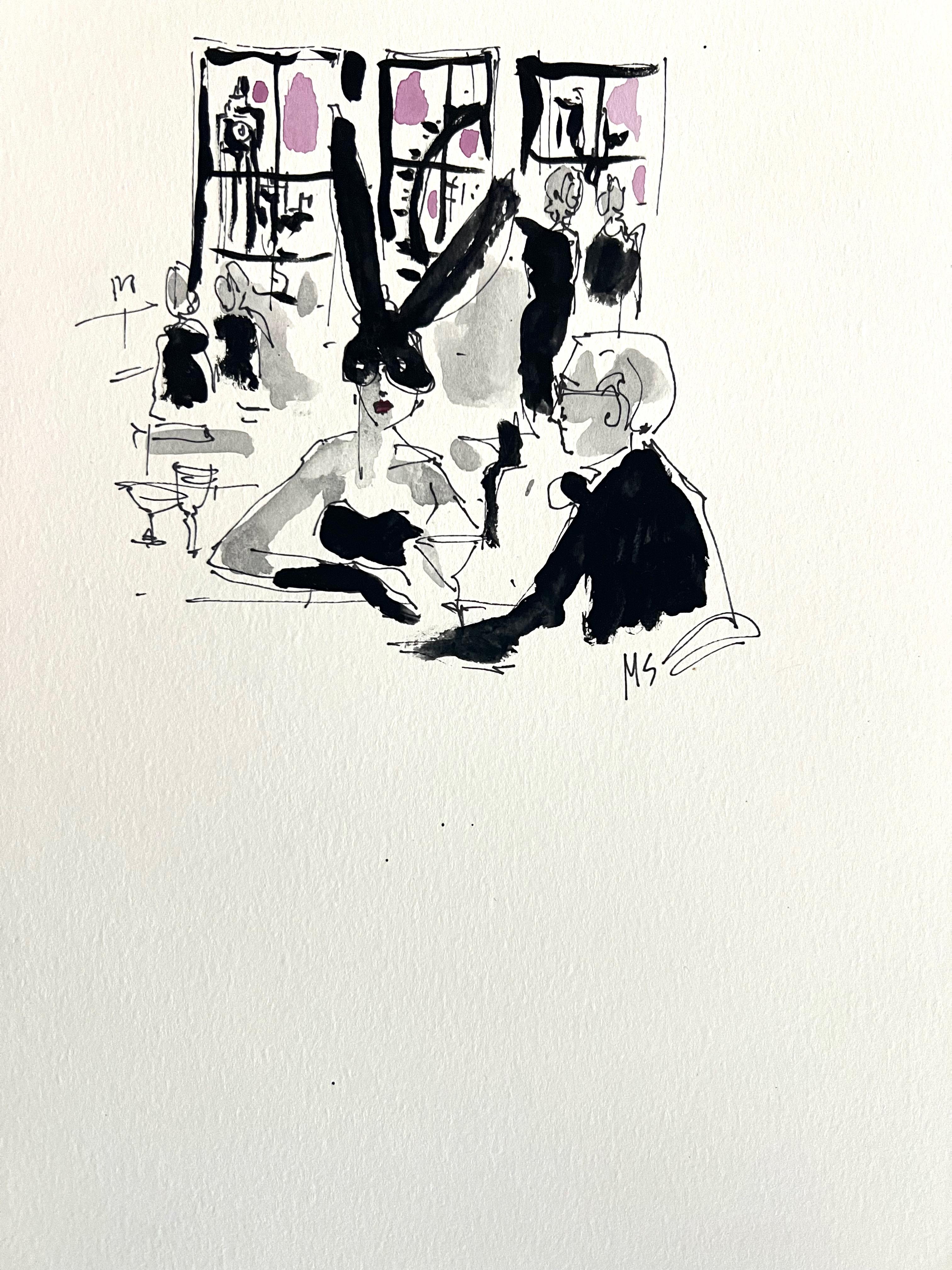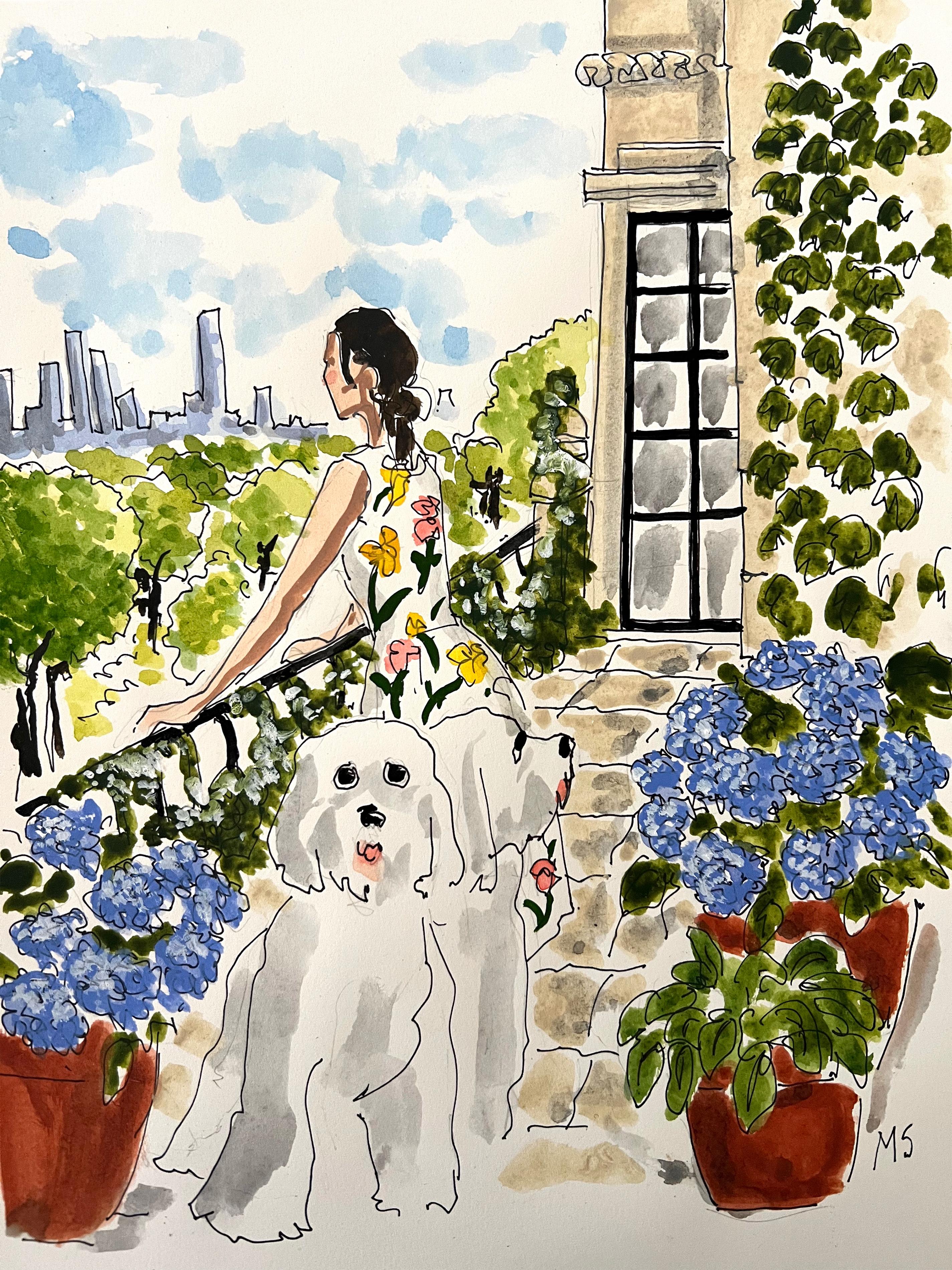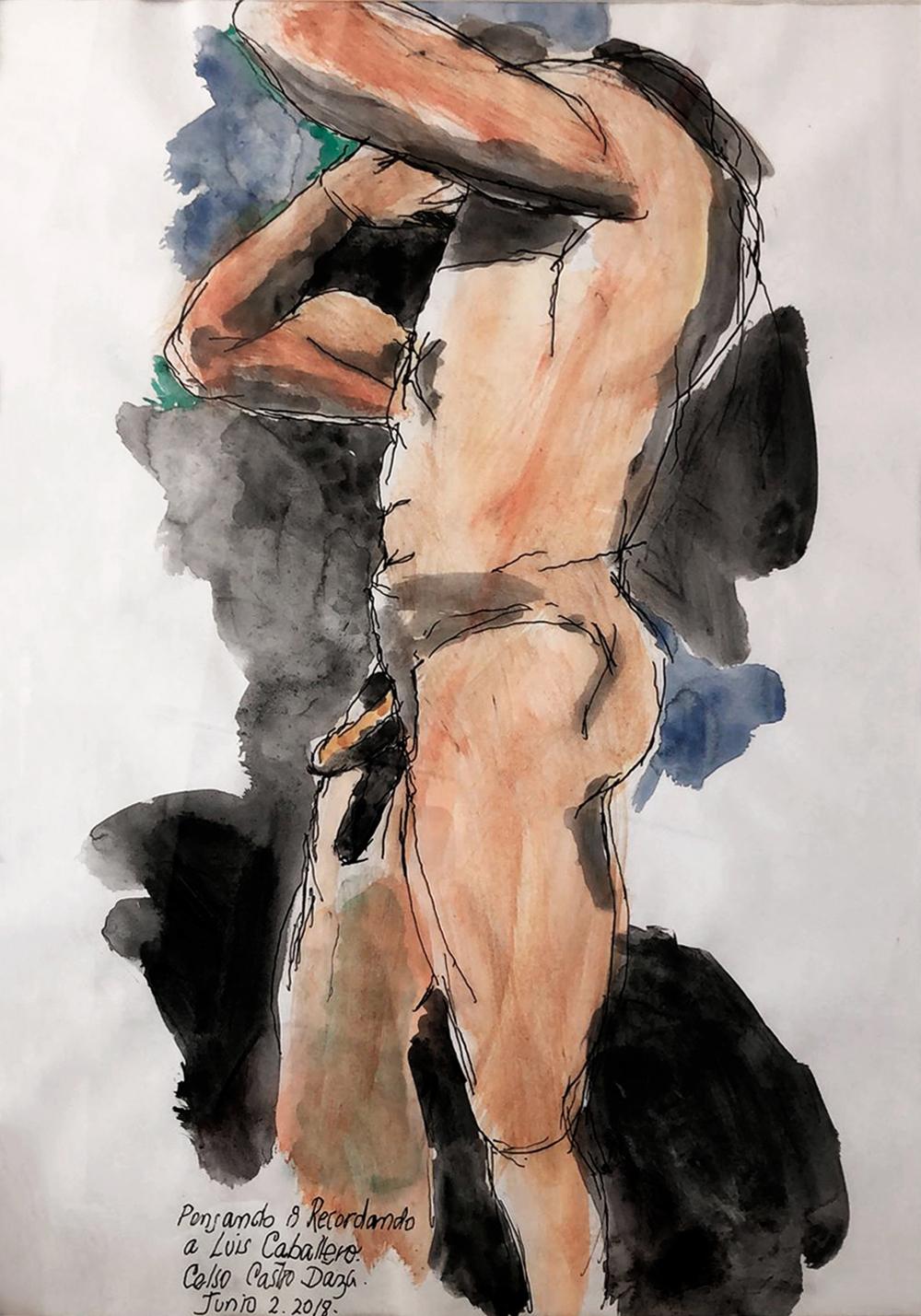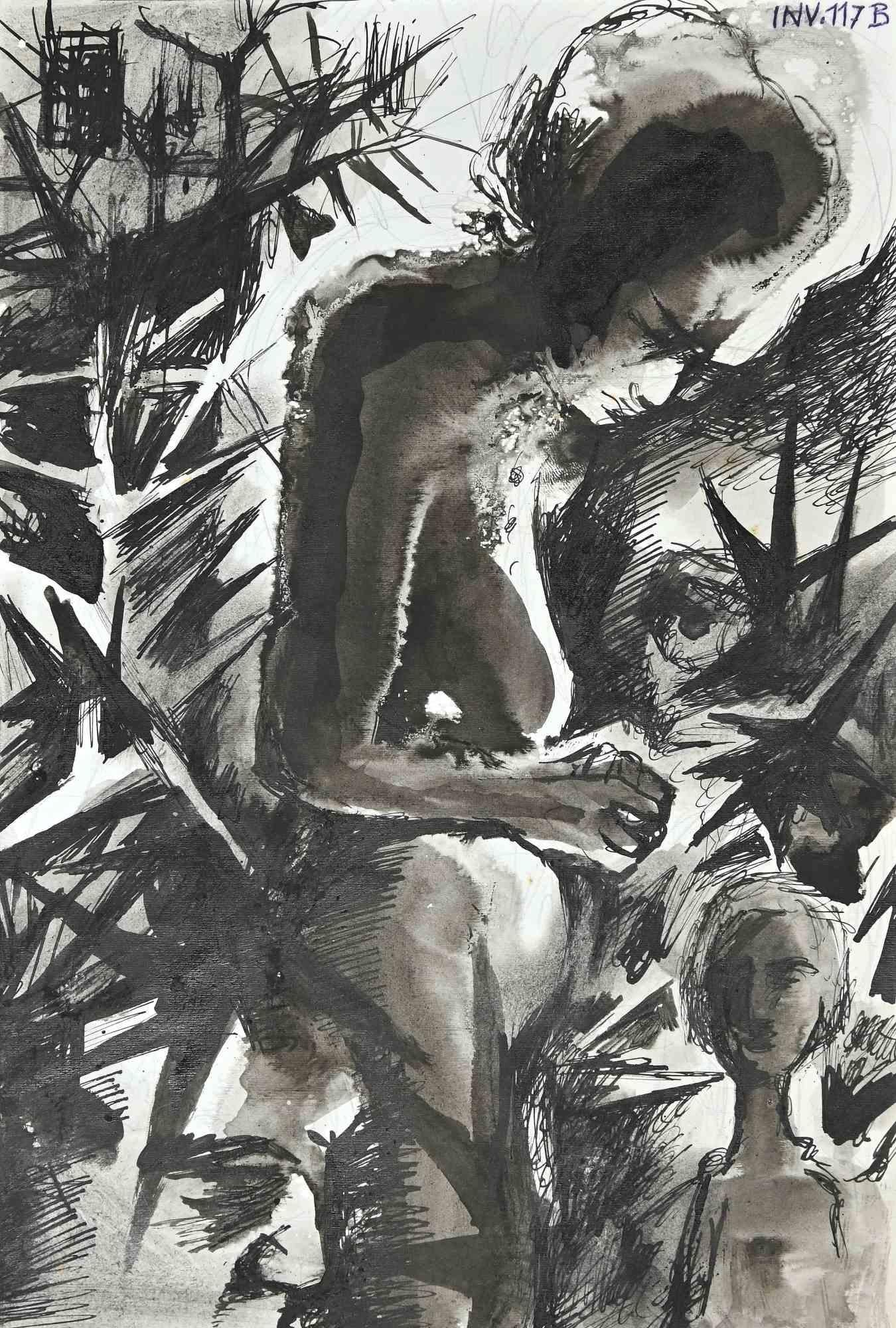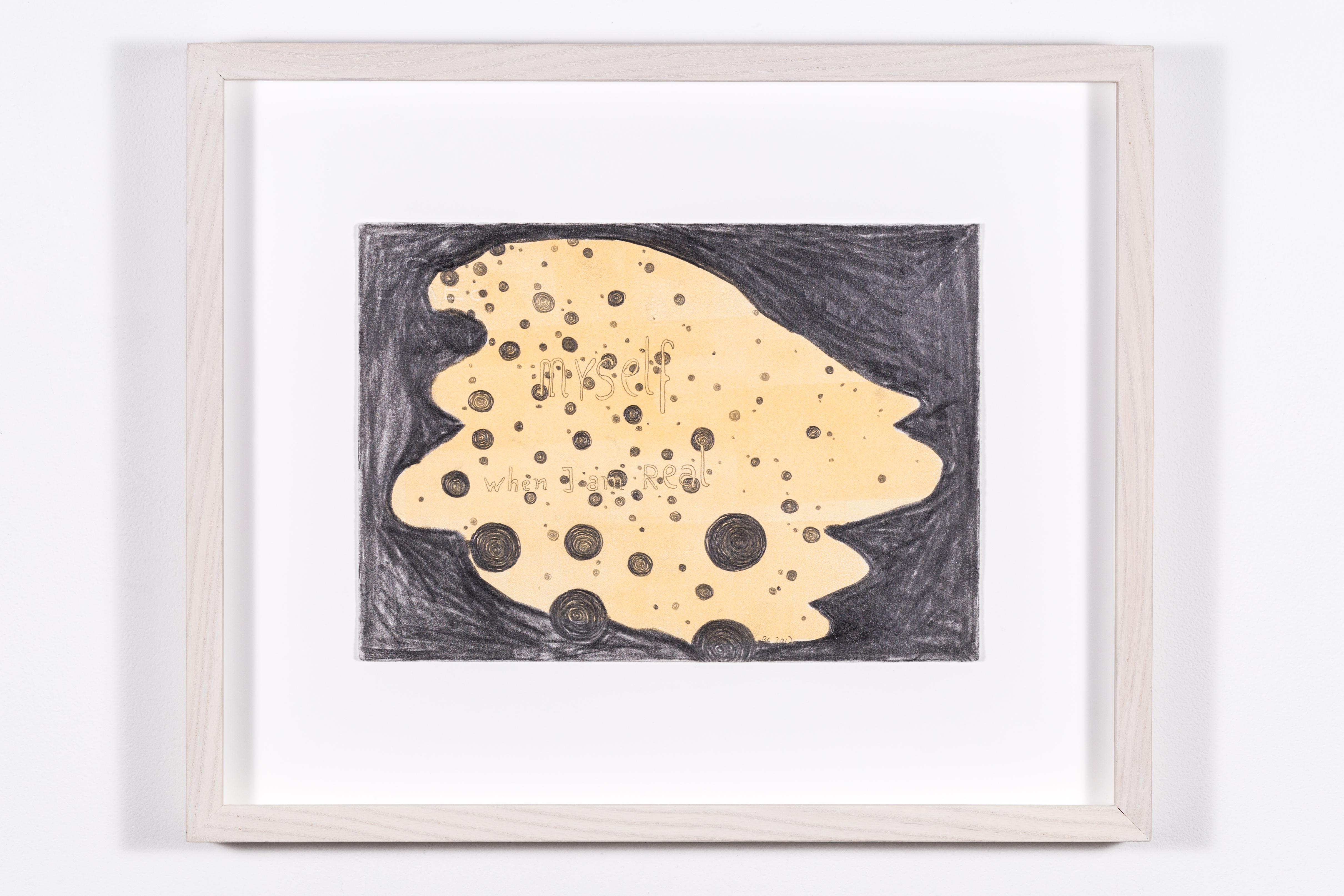John DobbsAbstract Modernist Drawing of a Nude Man with Winged Figure, Angel1978
1978
About the Item
- Creator:John Dobbs (1931 - 1911, American)
- Creation Year:1978
- Dimensions:Height: 10.25 in (26.04 cm)Width: 9.5 in (24.13 cm)
- Medium:
- Movement & Style:
- Period:
- Condition:minor waving to paper. minor wear.
- Gallery Location:Surfside, FL
- Reference Number:1stDibs: LU38213082912
John Dobbs
John Dobbs had many solo shows at galleries, universities and museums. His work was exhibited at the Museum of Modern Art, Whitney Museum of American Art, American Academy of Arts and Letters, Butler Institute of American Art in Ohio, and Salon Populiste in Paris. Dobbs’ paintings are part of the permanent collections of the Hirshhorn Museum, Washington, DC; the Montclair Art Museum, Montclair, New Jersey; the Neuberger Museum of Art, Purchase, New York; the Canton Museum of Art, Canton, Ohio and the Springfield Museum of Art, Springfield, Massachusetts. From 1972–96, Dobbs was a professor of art at John Jay College of Criminal Justice of the City University of New York. He was a member of the National Academy of Design, to which he was elected in 1976.
- ShippingRetrieving quote...Ships From: Surfside, FL
- Return PolicyA return for this item may be initiated within 3 days of delivery.
- Israeli Surrealist Painting Female Circus Performer Acrobat with CatBy Haya Graetz RanLocated in Surfside, FLVoluptuous, ala Fernando Botero, female circus performer with spectators and cat. Haya Ran was born in Holon, Israel in 1948 on the same date as the State of Israel was founded. From 1968 to 1973 Ran lived on Kibbutz Sasa. After her stay on the Kibbutz, she took courses on Graphics at The Technion 1975-1978. Tel Hai Institute Ran paints with water colors, using a multilayer method, which creates an illusion of tempera. Ran came up with this technique herself, influenced medieval painters. Ran says that the reds, browns, and golds in most of her feminist works are inspired by the performing arts: the circus, clowns, acrobats, dancers, and the fantastic. Haya Ran doesn’t identify today with any particular artistic school. Her works are born out of personal experiences and feelings. They come from the remembrances of her past, of her life and her experiences as a child, and from the fantasies she entertains about them. Her subjects emanate from her private, inner world. Haya Ran focuses on the world of the female. Her women are a peculiar lot. Their dimensions are offer wide, distorted, and grotesque, yet their poses and settings are as enticing and charming as they are sexually arousing. Others of Haya Ran’s women remain attached to elements of a lost childish innocence; dolls, wooden horses, masks, and wooden birds. Her works are executed with watercolors on paper. Her technique resembles that of Renaissance tempera. She superimposes strata and blends them together to create the impression of a past era. She creates not by putting down on paper her sudden impulses, but by devoting painstaking attention to the smallest details over countless hours. Selected Solo Exhibitions “Izraeliyot” / Dwek Gallery, Adenauer Conference Center, Mishkenot Sha’ananim, “Plowing” / Gerstein Gallery, Tel Aviv. Curated by Ora Krauss. “Suricattas” / Seemann Contemporary Art Gallery, Tel Aviv. Curated by Hagai Segev. “Encrypting” / The Israeli Artists Gallery, Kabri. Curated by Drora Dekel. Tokyo, Japan Museum of Art “O” “Calligraphy” / HaGalleria, Moshav Shoevah. Curated by Tirtzah Yallon Kolton. ESPACE RACHI, Paris, France. Curated by Hana Landau. Brucke Gallery, Braunschweig, Germany Gallery Vandorn, Paris, France Goldman Gallery, Haifa, Israel Grafica 3 Gallery, Haifa, Israel Select Group Exhibitions: Group Exhibitions The Second Biennale for Israeli Ceramics Eretz Israel Museum, Ramat Aviv, Tel Aviv Stern Gallery, Tel Aviv Artists:Reuven Rubin, Chaya Graetz Ran, Dorit Feldman, Anna Ticho, Abraham Hadad. Israeli Portrait Wilfrid Israel Museum, Oriental Art and Studies, Kibbutz Hazorea Artists: Shoshana Heimann,Genia Berger, Avraham Ofek, Jean David, Jakob Steinhardt, David Sharir, Ruth Schloss Ruth Zarfati Rudi Lehmann and others With this Ring - Wedding Ceremonies in Contemporary Art Beit Hatfutsot, Tel Aviv Artists: Nelly Agassi, Lital Dotan, Shai Azoulay, Avraham Baron Gallery, Beer Sheva Artists: Miki Kratsman, Adi Nes...Category
20th Century Contemporary Figurative Drawings and Watercolors
MaterialsPaper, Watercolor
- Man in Raincoat, Vintage Modern Watercolor PaintingBy John DobbsLocated in Surfside, FLAbstracted portrait of a man in a raincoat by artist John Dobbs. This impressionistic depiction of the subject allows for stylistic references to Monet, and Sisley. John Barnes Dobbs, a determinedly figurative painter who launched his career in the 1950s against the prevailing winds of Abstract Expressionism, lived to see a time when Realism would coexist with Abstraction, Minimalism, Conceptual Art and a variety of other artistic movements. On August 9 Dobbs died at his home in New York’s Greenwich Village at the age of 80. In his final works, Dobbs’ figures appear against flat backgrounds, iconic as the images on tarot cards: acrobats, boxers and contortionists, struggling against the physics of their own bodies and that of the universe. Dobbs had many solo shows at galleries, universities and museums. His work was exhibited at the Museum of Modern Art, the Whitney Museum, the American Academy of Arts and Letters, the Butler Institute of American Art in Ohio, and the Salon Populiste in Paris. Dobbs’ paintings are part of the permanent collections of the Hirshhorn Museum, Washington, DC; the Montclair Art Museum, Montclair, NJ; the Neuberger Museum, Purchase, NY; the Canton Museum of Art, Canton, OH and the Springfield Museum of Art, Springfield, MA. From 1972 to 1996, he was a Professor of Art at John Jay College, City University of New York. He was a member of the National Academy, to which he was elected in 1976. Born in 1931 in a small house by the Lackawanna Railroad...Category
20th Century Contemporary Figurative Drawings and Watercolors
MaterialsWatercolor
- 1930's American WPA Modernist New York City Watercolor Painting Harlem River DrBy Samuel GrunvaldLocated in Surfside, FLHarlem River Drive, 1938 (fauvist painting of men sitting on a park bench) image is 6.5 X 7.5 inches. Provenance: Greenwich Gallery (Greenwich CT) Samuel Grunvald was a Hungarian born American WPA artist known for abstract, landscape and seascape paintings. Arrived in the USA from Hungary in 1921 and settled in New York City where he studied at the Art Students League. Grunvald worked for the Federal Art Project, taught at Colony House in NYC. Member: Art Guild, Watercolor Society, New York Watercolor Club. exhibited at Montross Gallery, NYC, World House Galleries, NYC, Leonard Hutton Gallery, NYC, Associated American Artists Gallery and the A.C.A. Gallery. Gunvald's work spanned many modern American movements from the WPA to Abstract Expressionist painting. He was a member of the American Watercolor Society and the Brooklyn Society of Artists. He exhibited with both of these organizations and at the Brooklyn Museum of Art. He was involved the the WPA being a Federal Arts Project artist. A number of prominent Jewish artists participated in this New Deal program among them Ben Shahn, William Gropper, Philip Guston Adolph Gottlieb, Mark Rothko, Milton Avery, Ben Shahn, the Soyers (Isaac, Moses, and Raphael), and many others Grunwald exhibited alongside other popular artists such as Paul Klee, Jean Arp, Max Ernst and Charles Burchfield. He also taught and lectured on art and easel painting, Federal Art Project, NYC. His work is included in the collections of the Museum of Modern Art and The Jewish Museum, New York. Select Exhibitions A.C.A. Gallery Associated American Artists Gallery, 1936-1955 American Watercolor Society, 1932-1942 New York Watercolor Club, 1935-1937 Humanist Art...Category
20th Century Modern Figurative Drawings and Watercolors
MaterialsWatercolor
- Modernist Watercolor Painting Peter Goldman American Filmmaker Neo ExpressionistBy Peter Emanuel GoldmanLocated in Surfside, FLPoetry piece. Based on poem or song. Washington Square New York Watercolor painting hand signed by Peter Emanuel Goldman. Legendary French American Film Auteur, These are recently p...Category
21st Century and Contemporary Neo-Expressionist Abstract Drawings and Wa...
MaterialsPaper, Watercolor
- Post Soviet Avant Garde Russian Woodcut Print With Hand Watercolor PaintingBy Ilya ShenkerLocated in Surfside, FLThis depicts a feast style celebration scene in a style of German Expressionism. hand signed and hand painted in watercolor. Ilya Shenker, Russian/American (1922 - ) As a soldier in World War II, he survived where millions perished. Upon returning to his home town of Odessa, felt abandoned and alone. He studied Art and Architecture in Odessa, but, one of a number of Russian Jewish artists allowed to emigrate, he left for America when the opportunity arose. He settled in New York City, a choice that has forever impacted his oeuvre. Many of his pictures depict New York cityscapes and lifestyle; however, they remain typically Russian. His subject matter often comes from memory and includes the life that he left behind, family, and friends. Drawing upon his Jewish heritage for inspiration, Shenker also paints historical events, such as "On the Eve of the Assault" in which he portrayed the last night before the destruction of Jerusalem. He has also illustrated a number of classics of Russian literature including Alexander Pushkin. His use of imagination also applies to the figures in his expressionist paintings—fictional characters such as the Spanish literary character Don Quixote make appearances in his work. He has also placed figures such as Rembrandt and Picasso in modern settings: in "Rembrandt Visiting our Family," Shenker sits his most favored artist at his family table, in a tribute to someone he describes as a "peoples artist." He is one in a long line of great Soviet Russian Judaica Jewish artists beginning with Yehuda Pen, who founded Russia's first art school for Jews in Vitebsk in 1897 continuing with his students, including Marc Chagall and El Lissitzky, Natan Altman, Leon Bakst and Robert Falk...Category
1960s Expressionist Figurative Prints
MaterialsWatercolor, Woodcut
- Aquatint Etching with Hand Watercolor Painting Jules Pascin SignedBy Jules PascinLocated in Surfside, FLGenre: German Expressionist Subject: Three Noble figures, Noblesse Medium: etching, watercolor paint (I have seen this described as an aquatint and have seen this without color, so i am assuming it is watercolor paint applied to it) Surface: Paper Circa 1920's This is hand signed lower right. the edition is 7/100 Mat measures 15 X 11. window opening about 7 x 7 Julius Mordecai Pincas (March 31, 1885 – June 5, 1930), known as Pascin Jules Pascin, or the "Prince of Montparnasse", was a Bulgarian artist known for his paintings and drawings. He later became an American citizen. His most frequent subject was women, depicted in casual poses, usually nude or partly dressed. Pascin was educated in Vienna and Munich. He traveled for a time in the United States, spending most of his time in the South. He is best known as a Parisian painter, who associated with the artistic circles of Montparnasse, and was one of the emigres of the School of Paris. Having struggled with depression and alcoholism, he committed suicide at the age of 45. Julius Mordecai Pincas was born in Vidin, Bulgaria, the eighth of eleven children, to the Sephardic Jewish family of a grain merchant named Marcus Pincas. Originally from Ruse, the Pincas family was one of the wealthiest in Vidin; they bought and exported corn, rice, maize and sunflower. His mother, Sofie (Sophie) Pincas, belonged to a Sephardic family, Russo, which had moved from Trieste to Zemun, where she and her husband lived before moving to Vidin and where their older children were born. The family spoke Ladino Judaeo-Spanish at home. In 1892, he moved with his parents to Bucharest, where his father opened a grain company, "Marcus Pincas & Co". Pascin worked briefly for his father’s firm at the age of fifteen, but also frequented a local brothel where he made his earliest drawings. His first artistic training was in Vienna in 1902 at age seventeen. In 1903 he relocated to Munich, where he studied at Moritz Heymann's academy. He studied briefly in Berlin where he befriended the Dada artist George Grosz. In 1905 he began contributing drawings to Simplicissimus, a satirical magazine published in Munich. Some portraits recall Otto Dix and Balthus. Because his father objected to the family name being associated with these drawings, the 20-year-old artist adopted the pseudonym Pascin (an anagram of Pincas). He continued to contribute drawings to a Munich daily until 1929. In December 1905, Pascin moved to Paris becoming part of the great migration of Jewish and Eastern European artists to that city (Marc Chagall. Chaim Soutine and Modigliani amongst others) at the start of the 20th century. In 1907 he met Hermine Lionette Cartan David, also a painter, and they became lovers. In that same year he had his first solo exhibition at Paul Cassirer Gallery in Berlin. Despite his social life, Pascin created thousands of watercolors and sketches, plus drawings and caricatures that he sold to various newspapers and magazines. He exhibited his works in commercial galleries and in the Salon d’Automne, the Salon des Indépendants, and the exhibitions of the Berlin Secession and at the Sonderbund-Aussstellung in Cologne. Between 1905 and 1914 he exhibited drawings, watercolors, and prints, but rarely paintings. It was not until about 1907–1909 that he produced his first paintings, which were portraits and nudes in a style influenced by Fauvism and Cézanne. He wanted to become a serious painter, but in time he became deeply depressed over his inability to achieve critical success with his efforts. Dissatisfied with his slow progress in the new medium, he studied the art of drawing at the Académie Colarossi, and painted copies after the masters in the Louvre. He exhibited in the United States for the first time in 1913, when twelve of his works were shown at the Armory Show in New York. Pascin relocated to London at the outbreak of World War I to avoid service in the Bulgarian army and left for the United States on October 3, 1914. A few weeks later on October 31, Hermine David sailed for the United States to join him. Pascin and David lived in the United States from 1914 to 1920, sitting out World War I. They visited New York City, where David had an exhibit. Pascin frequented nightclubs, and met artists such as Yasuo Kuniyoshi and Guy Pene du Bois, but most of his time in America was spent traveling throughout the South. He also visited Cuba. He made many drawings of street life in Charleston, New Orleans, and other places he visited. Some of his works of 1915 and 1916 are in a Cubist style, which he soon abandoned. In 1918 Pascin married Hermine David at City Hall in New York City. Their witnesses were Max Weber and Maurice Sterne, friends and painters who both lived in New York. In September 1920, Pascin became a naturalized United States citizen, with support from Alfred Stieglitz and Maurice Sterne, but returned to Paris soon afterward. There he began a relationship with Lucy Vidil Krohg, who had been his lover ten years earlier but had married the Norwegian painter Per Krohg...Category
Early 20th Century Expressionist Figurative Drawings and Watercolors
MaterialsPaper, Watercolor, Etching
- Elsa Peretti goes out for a drink. From the Art, culture & society seriesBy Manuel SantelicesLocated in Miami Beach, FLElsa Peretti goes out for a drink, 2024 by Manuel Santelices From the Art, culture & society series Unframed Movies, TV. and magazines are constant source of inspiration. Fame, as f...Category
21st Century and Contemporary Contemporary Figurative Drawings and Water...
MaterialsPaper, Gouache, Ink
- I Miss YouBy Jade BocquillonLocated in West Hollywood, CAWe are premiering the paintings of a just discovered French artist Jade Bocquillon. A gifted artist living in Provence in the South of France, The work of Jade Bocquillon evokes deep feeling and emotion, combined with the artist's natural detailed style of painting. These paintings have just arrived from the personal collection of the artist, this will be the first time they have been available for sale. I MIss You...Category
2010s Contemporary Figurative Paintings
MaterialsWatercolor
- A view of the Park. From the Art, culture & society seriesBy Manuel SantelicesLocated in Miami Beach, FLA view of the Park, 2024 by Manuel Santelices From the Art, culture & society series Ink and watercolor on Arches paper Image size: 14 in. H x 11 in. W Unframed Movies, TV. and mag...Category
21st Century and Contemporary Contemporary Figurative Drawings and Water...
MaterialsPaper, Ink, Watercolor
- Pensando & recordando a Luis Caballero, Nude Watercolor on paperBy Celso José Castro DazaLocated in Miami Beach, FL"Pensando & recordando a Luis Caballero" by Celso Castro-Daza From the Duchándome Series Watercolor, pastel, and ink on archival paper Sheet size: 19.5 ...Category
2010s Contemporary Nude Drawings and Watercolors
MaterialsPastel, Archival Ink, Watercolor, Archival Paper
- Indigenous Woman - Drawing by Leo Guida - 1970sBy Leo GuidaLocated in Roma, ITIndigenous Woman is a modern artwork realized by Leo Guida in the 1970s. Good condition. Ink and watercolor on paper. Leo Guida has been able to weave a productive interview on ar...Category
1970s Contemporary Figurative Drawings and Watercolors
MaterialsInk, Watercolor, Paper
- Myself when I am RealBy Robbie CornelissenLocated in Montreal, QuebecRobbie Cornelissen is one of the leading contemporary draughtsmen in the Netherlands. Cornelissen has established a reputation for the monumental, architectural drawings that he has ...Category
2010s Contemporary Figurative Drawings and Watercolors
MaterialsArchival Paper, Graphite, Watercolor
